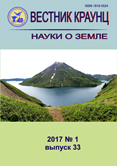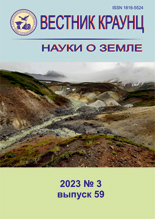Abstract
When studying the material composition of sedimentary formations, the problem of identifying extraterrestrial matter arises, in particular, distinguishing cosmic spherules from technogenic and volcanogenic ones. Based on the results of study of a collection of 482 volumetric spherules separated from ferromanganese crusts from the Pacific Ocean floor, an additional feature of such identification based on relief forms on the surface of spherules is proposed. The article gives a detailed description of such relief forms arising during the passage by cosmic particles through the upper layers of the Earth’s atmosphere, isolation and separation of the Fe-Ni cores from the spherules. The presence of a round hemispherical cavity on the flattened side of the spherule, a depression with concentric circles, or a «button» structure, as well as the presence of a Fe-Ni core is a sufficient but not necessary sign to consider a spherule cosmogenic.
References
Рычагов С.Н., Кравченко О.В., Сандимирова Е.И., Философова Т.М. Вулканическое стекло в цеолит-кремнистых отложениях Паужетского геотермального месторождения (Южная Камчатка) // Вулканизм и связанные с ним процессы. Материалы XXVI ежегодной научной конференции, посвященной Дню вулканолога, 30-31 марта 2023 г. Петропавловск-Камчатский: ИВиС ДВО РАН, 2023. С. 168–171 [Rychagov S.N., Kravchenko O.V., Sandimirova E.I., Phylosofova T.M. Volcanic glass in zeolite-siliceous deposits of the Pauzhetsky geothermal field (South Kamchatka) // Volcanism and related processes. Proceedings of the XXVI annual scientific conference dedicated to the Volcanologist Day, March, 30-31, 2023. Petropavlovsk-Kamchatsky: IVS FEB RAS, 2023. P. 168–171 (in Russian)].
Савельев Д.П., Савельева О.Л., Москалева С.В., Рашидов В.А. Состав космогенных сферул из железомарганцевых корок Магеллановых гор // Геохимия. 2022. Т. 67. № 5. С. 413–422. https://doi.org/10.31857/S0016752522050090 [Savelyev D.P., Savelyeva O.L., Moskaleva S.V., Rashidov V.A. Composition of Cosmic Spherules from Ferromanganese Crusts of the Magellan Seamounts // Geochemistry International. 2022. V. 60. № 5. P. 411–420. https://doi.org/10.1134/S0016702922050081].
Савельев Д.П., Ханчук А.И., Савельева О.Л. и др. Первая находка платины в космогенных сферулах железомарганцевых корок (гайот Федорова, Магеллановы горы, Тихий океан) // Доклады Российской Академии наук. Науки о Земле. 2020. Т. 491. № 2. С. 15–19. https://doi.org/10.31857/S2686739720040155 [Savelyev D.P., Khanchuk A.I., Savelyeva O.L. et al. First Find of Platinum in Cosmogenic Spherules of Ferromanganese Crusts (Fedorov Guyot, Magellan Seamounts, Pacific Ocean) // Doklady Earth Sciences. 2020. V. 491. № 2. P. 199–203). https://doi.org/10.1134/S1028334X20040157].
Савельева О.Л., Савельев Д.П., Москалева С.В. Космогенные сферулы в океане // Природа. 2020. № 7. С. 31–36. [Savelyeva O.L., Savelyev D.P., Moskaleva S.V. Cosmogenic Spherules in the Ocean // Priroda. 2020. № 7. P. 31–36 (in Russian)]. https://doi.org/10.7868/S0032874X20070042
Сандимирова Е.И., Главатских С.Ф., Рычагов С.Н. Магнитные сферулы из вулканогенных пород Курильских островов и Южной Камчатки // Вестник КРАУНЦ. Науки о Земле. 2003. № 1. С. 135–140 [Sandimirova E.I., Glavatskikh S.F., Rychagov S.N. Magnetic Spherules from Volcanogenic Rocks of the Kuril Islands and Southern Kamchatka // Vestnik KRAUNTs. Nauki o Zemle. 2003. № 1. P. 135–140 (in Russian)].
Badyukov D.D. Micrometeorites from the Novaya Zemlya Ice Sheet // Advances in Geochemistry, Analytical Chemistry, and Planetary Sciences: 75th Anniversary of the Vernadsky Institute of the Russian Academy of Sciences. Cham: Springer International Publishing, 2023. P. 323–334. https://doi.org/10.1007/978-3-031-09883-3_17
Bi D., Morton R.D., Wang K. Cosmic nickel-iron alloy spherules from Pleistocene sediments, Alberta, Canada // Geochimica et Cosmochimica Acta. 1993. V. 57. № 16. P. 4129–4136. https://doi.org/10.1016/0016-7037(93)90359-5
Brownlee D.E. Cosmic dust: Collection and research // Annual Review of Earth and Planetary Sciences. 1985. V. 13. № 1. P. 147–173.
Brownlee D.E., Bates D.A., Wheelock M.M. Extraterrestrial Pt-group nuggets in deep sea sediments // Nature. 1984. V. 309. № 5970. P. 693–695. https://doi.org/10.1038/309693a0
Dekov V.M., Molin G.M., Dimova M. et al. Cosmic spherules from metalliferous sediments: A long journey to the seafloor. // Neues Jahrbuch für Mineralogie-Abhandlungen: Journal of Mineralogy and Geochemistry. 2007. V. 183. № 3. P. 269–282. https://doi.org/10.1127/0077-7757/2007/0073
Engrand C., McKeegan K.D., Leshin L.A. et al. 2005. Isotopic compositions oxygen, iron, chromium, and nickel in cosmic spherules: Toward a better comprehension of atmospheric entry heating effects // Geochimica et Cosmochimica Acta. 2005. V. 69. № 22. P. 5365–5385. https://doi.org/10.1016/j.gca.2005.07.002
Folco L., Cordier C. Micrometeorites // European Mineralogical Union Notes in Mineralogy. 2015. V. 15. Ch. 9. P. 253–297.
Genge M.J., Engrand C., Gounelle M., Taylor S. The classification of micrometeorites // Meteoritics and Planetary Science. 2008. V. 43. № 3. P. 497–515. https://doi.org/10.1111/j.1945-5100.2008.tb00668.x
Genge M.J., Larsen J., Van Ginneken M., Suttle M.D. An urban collection of modern-day large micrometeorites: Evidence for variations in the extraterrestrial dust flux through the Quaternary // Geology. 2017. V. 45. № 2. P. 119–122. https://doi.org/10.1130/G38352.1
Genge M.J., Van Ginneken M., Suttle M.D. Micrometeorites: Insights into the flux, sources and atmospheric entry of extraterrestrial dust at Earth // Planetary and Space Science. 2020. V. 187. P. 104900. https://doi.org/10.1016/j.pss.2020.104900
Halbach P., Kriete C., Prause В., Puteanus D. Mechanisms to explain the platinum concentration in ferromanganese seamount crusts // Chemical Geology. 1989. V. 76. № 1–2. P. 95–106. https://doi.org/10.1016/0009-2541(89)90130-7
Hein J.R., Mizell K., Koschinsky A., Conrad T.A. Deep-ocean mineral deposits as a source of critical metals for high- and green-technology applications: Comparison with land-based resources // Ore Geology Reviews. 2013. V. 51. P. 1–14. https://doi.org/10.1016/j.oregeorev.2012.12.001
Herzog G.F., Xue S., Hall G.S. et al. Isotopic and elemental composition of iron, nickel, and chromium in type I deep-sea spherules: Implications for origin and composition of the parent micrometeoroids // Geochimica et Cosmochimica Acta. 1999. V. 63. № 9. P. 1443–1457. https://doi.org/10.1016/S0016-7037(99)00011-3
Murray S., Renard A.F. Report on deep-sea deposits based on the specimens collected during the voyage of H.M.S. Challenger in the years 1872 to 1876. London: Neill and Co, 1891. 525 p. hdl:10013/epic.45942
Raisbeck G.M., Yiou F. 10Be and 26Al in micrometeorites from Greenland ice // Meteoritics. 1987. V. 22. P. 485.
Rubin A.E., Grossman J.N. Meteorite and meteoroid: New comprehensive definitions // Meteoritics and Planetary Science. 2010. V. 45. № 1. P. 114–122. https://doi.org/10.1111/j.1945-5100.2009.01009.x
Rudraswami N.G., Parashar K., Shyam Prasad M. Micrometer- and nanometer-sized platinum group nuggets in micrometeorites from deep-sea sediments of the Indian Ocean // Meteoritics and Planetary Science. 2011. V. 46. № 3. P. 470–491. https://doi.org/10.1111/j.1945-5100.2011.01169.x
Rudraswami N.G., Shyam Prasad M., Babu E.V.S.S.K., Vijaya Kumar T. Chemistry and petrology of Fe-Ni beads from different types of cosmic spherules: Implication for precursors // Geochimica et Cosmochimica Acta. 2014. V. 145. P. 139–158. https://doi.org/10.1016/j.gca.2014.09.029
Taylor S., Lever J.H., Harvey R.P. Numbers, types, and compositions of an unbiased collection of cosmic spherules // Meteoritics and Planetary Science. 2000. V. 35. № 4. P. 651–666. https://doi.org/10.1111/j.1945-5100.2000.tb01450.x
Van Ginneken M., Genge M.J., Folco L., Harvey R.P. The weathering of micrometeorites from the Transantarctic Mountains // Geochimica et Cosmochimica Acta. 2016. V. 179. P. 1–31. https://doi.org/10.1016/j.gca.2015.11.045
Zhang H., Shen S.Z., Cao C.Q., Zheng Q.F. Origins of microspherules from the Permian–Triassic boundary event layers in South China // Lithos. 2014. V. 204. P. 246–257. https://doi.org/10.1016/j.lithos.2014.02.018

This work is licensed under a Creative Commons Attribution-NonCommercial 4.0 International License.
Copyright (c) 2023 О.Л. Савельева, Д.П. Савельев, О.А. Зобенько

